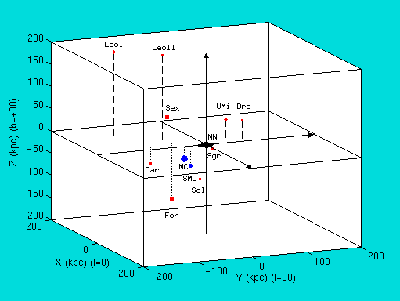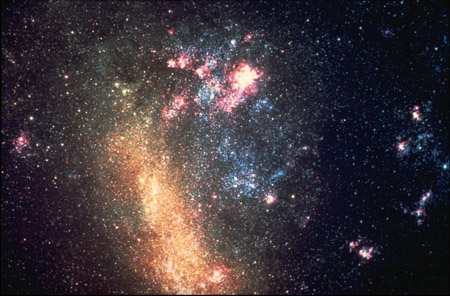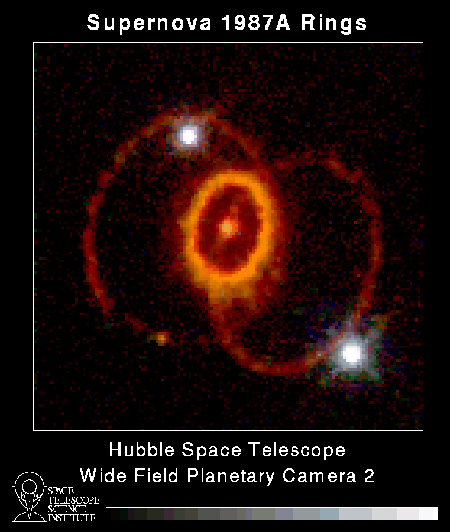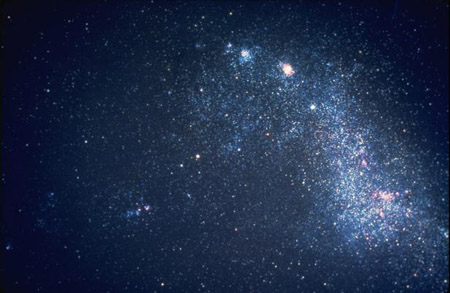Our
Milky Way galaxy is a part of a larger group,
but there are several smaller
galaxies that are
close enough to us to be considered "satellite
galaxies." There are 12 known satellites of
our
galaxy:
| Name: |
Distance (Light-Years): |
Diameter (Light-Years): |
| Sagittarius Dwarf (Sgr) |
50,000 |
10,000 |
| Large Magellanic Cloud |
160,000 |
20,000 |
| Small Magellanic Cloud |
180,000 |
15,000 |
| Ursa Minor Dwarf Galaxy (UMi) |
220,000 |
1000 |
| Sculptor Dwarf Galaxy (Scl) |
260,000 |
1000 |
| Draco Dwarf Galaxy (Dra) |
270,000 |
500 |
| Sextans Dwarf Galaxy (Sex) |
290,000 |
3000 |
| Carina Dwarf Galaxy (Car) |
330,000 |
500 |
| Fornax Dwarf Galaxy (For) |
450,000 |
3000 |
| Leo II Dwarf Galaxy (LeoII) |
670,000 |
500 |
| Leo I Dwarf Galaxy (LeoI) |
830,000 |
1000 |
| Pegasus Dwarf Galaxy |
2,600,000, |
2000 |
The last eight dwarfs (small galaxies) are in the
direction of the named constellation, but the stars
of the constellations are in our
own galaxy.

With the exception of the Large and Small
Magellanic Clouds, all of our satellite galaxies are
of the Dwarf Spheroidal class. These
galaxies were
once thought of as
globular clusters, but these
dwarf galaxies are different by two major
differences:
-
Globular clusters contain old
stars of the
same population - the Dwarf Galaxies also
contain old
stars, but of as more expanded
variety (i.e. they did not form from the same,
single molecular cloud)
- The Mass to Luminosity ratios are much
higher in Dwarf Galaxies than in
Globular
Clusters - this means there is significant
levels of Dark Matter in Dwarf's
In addition, dwarf galaxies seem to have a higher
ratio of Iron versus
globulars. What that means is
not entirely clear, but indicates that some newer
stars must also have existed within the dwarf in the
past.
We do not have many images of our dwarf
neighbors, but here is an image of the Sagittarius
Dwarf Galaxy:

Another dwarf galaxy, the farthest satellite
galaxy, is the Leo I dwarf galaxy:

The newest member of our satellite
galaxies is
the Pegasus Dwarf Galaxy. This galaxy was discovered
by the Keck telescope (it was hidden until then by
the glare from M31 - the Andromeda Galaxy). This is
a larger dwarf that contains blue
stars:

These dwarf galaxies are beyond the view of the
unaided eye, and though a
telescope might be
confused as a
globular clusters. But there are two
satellites that are unmistakable: The Large and
Small Magellanic Clouds.
These two irregular
galaxies reside in the
Southern skies and therefore hidden from view to
those of us in the United States, Canada and Europe.
The Large Magellanic Cloud:

This galaxy is classified as an irregular
galaxy
that may have tiny arms. Its distorted shape is
though to be the result of the gravity from our
galaxy.
The Large Magellanic Cloud is host to the
Tarantula Nebula and the very important supernova
remnant of SN1987a - the
supernova that proved a
flood of
neutrinos does emanate from the dying core.
The Tarantula Nebula:

A nebula like this, containing a large amount of
dust and hydrogen, is though to be a nursery for new
stars to be born.
SN1987a:

The Small Magellanic Cloud has its own share of
notoriety. In 1912, Henrietta Leavitt discovered a
period/luminosity relation of a newly discovered
variable called a
Cepheid variable from within the
Small Magellanic Cloud. Her discovery would allow
the accurate measure of long distances by using the
Cepheid period/luminosity as a ruler.

The Small Magellanic Cloud (above) is also
considered an irregular
galaxy, but does not have
the near distinct central bar or arms of the Large Magellanic Clouds.
Back to Top |

